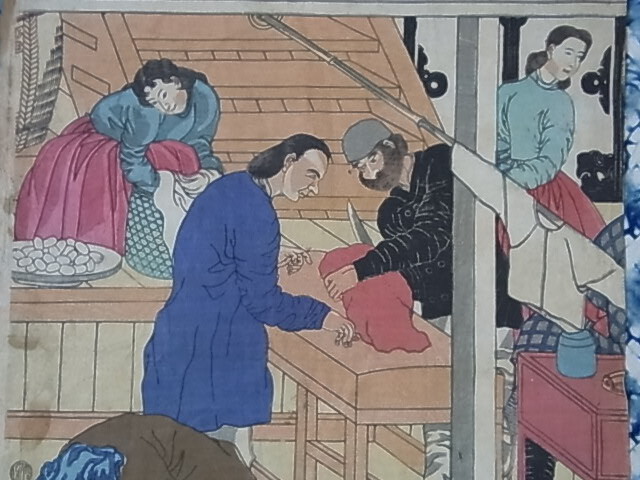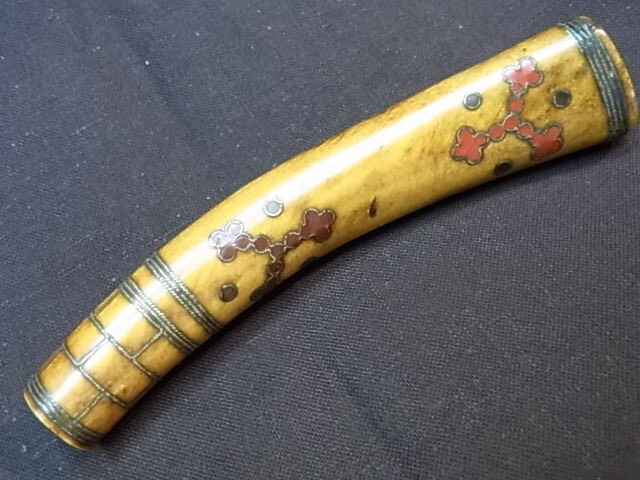-
Posts
11,759 -
Joined
-
Last visited
-
Days Won
158
Content Type
Profiles
Forums
Events
Store
Downloads
Gallery
Everything posted by Bugyotsuji
-
Here are most of mine, alongside a kisseru for comparison. 2 with Mei on the blades were bought at an antiques show in Himeji, and 7 came directly from a Kura of Kameyama Castle in northern Ise, a descendant of the Karo having the keys. The biggest yajiri looks like a small yari no ho.
-
Well, looking at the long stroke coming down from above, my instinct is to go for Sakuyo, which is Mimasaka/Tsuyama in Okayama. There are no Goto listed for that area, however. Sakiyo if that's how you read it, is an area of Nagasaki. Satsuyo is a broad area of Satsuma. I included these because there seem to be some Goto family names dotted around Kyushu. I even wonder if there is some connection between the Go in Goto and the Go in Bungo, Chikugo and Higo, for example. (Same Kanji) The actual name Magoshiro you show there which Morita San kindly read for us, is listed in Urabe but with no lower name, and no information as to location. Your gun's details seem not to have been recorded by either Urabe or Yasuda/Ogasawara and would add to the knowledge. There are Goto smiths listed for Settsu, as you mention, Bungo (Kyushu) and Ashu (Awa, Shikoku). (Presumably this gun is now outside Japan.) Unfortunately there seems to be little to go on, without delving into more local archives, which work is mostly what Urabe San does. PS There is a Goto listing with the same unusual Kanji lower name Nobumura, but the middle name is different. Goto "Buntaro" (?) 豊太郎 Nobumura, but again no location. Is the Bun of Buntaro an indication of 豊後 Bungo in Kyushu?
-

This Week's Edo Period Corner
Bugyotsuji replied to Bugyotsuji's topic in General Nihonto Related Discussion
Many thanks Ron. I have been trawling the internet hoping to pick up this particular image but no luck yet. Found some other prints which look stylistically similar, particularly in the poses and dresses of the females. -
It will be something like Sakuyo-Ju 作陽住 Sakiyo 崎陽 Satsuyo 薩陽perhaps.
-

This Week's Edo Period Corner
Bugyotsuji replied to Bugyotsuji's topic in General Nihonto Related Discussion
Good find Eric. That has a good feel to it. Got the pistol back this evening and he's done a wonderful job. Now it is becoming clear that the swordsmith is a different one with the same name, so I will be letting that float back onto the ocean. (There is however an example of a Hono-to sword made for a shrine in Yamaguchi which reportedly bears the same smith's name, so I may be taking a trip west to see it and compare Mei.) Quick question. Recently I acquired a single frame of a triptych by Utagawa Sadahide. It shows what looks like two American women and some slaves (?) working round a butcher's table. Pre-Civil War? Plucking a duck before a dog in the foreground. Bloody and graphic. Does it ring any bells among the members here? -
Interesting as the name Unkai means "a sea of clouds", usually viewed from a hilltop over a valley filled with rolling early-morning mist or clouds. I wonder if the shape of the edging is a play on that?
-

This Week's Edo Period Corner
Bugyotsuji replied to Bugyotsuji's topic in General Nihonto Related Discussion
Apologies for the sparse nature of the Corner recently. My fault entirely. Luckily there are other interesting threads ongoing for the readers, so no time for boredom! Several objects have indeed fluttered or cluttered their way into my grubby hands and/or camera memory card of late, so I promise to add fuel to the embers, very soon. Lost Netsuke, Ojime, Ukiyo-e, Ko-go-ire, compasses, lacquer boxes, what shall it be? One update is that the Bizen/Satsuma pistol has had a replacement pin with silver head made for it. Should be collecting this evening. Unfortunately a good friend who is also an avid collector has his eye on it... Also we are on for Maizuru this weekend where I should be meeting the ex-Prime Minister of Japan, Mr Hosokawa and his wife. Nowadays he throws pots in Nagoya, it is said. He would be the present Daimyo of Kumamoto. As you know his family were once based in Maizuru, Tanabe Castle, (Tokugawa Eastern army) I believe, where we are doing a full-armour/armor matchlock display. Last time we were there, five years ago, they asked me to step forward and fire the Rei-sha 礼射 opening ceremonial shot. (My long gun is an armory matchlock from Kumamoto Castle, dated, signed and variously marked, so they thought this would be fitting.) http://ja.wikipedia.org/wiki/%E7%94%B0% ... 6%E3%81%84 -
Yes, I have seen modern repros but there is something about them that does not attract. Is the rust too smooth and too consistent, even through the blade, and as Ron suggests, are the nakago edges too well defined? So far I have managed to avoid buying a fake, but they are out there, although not really in vast quantities. I suppose real ones come up so few and far between that over-eager people snap up the fakes when they show their heads. There are many new versions of the big beautiful cut-outs too, but new or old, they are prohibitively expensive. I'll take some new shots and add mine to this thread with comments. I know the provenance of some of them. A good opportunity to update the records. (Still stunned by the quality and variety above. )
-
Not so sure about the superstition, but those little flechettes in full polish are intensely beautiful to look at.
-
Thanks Ron, That is some Mei for an arrowhead! (Did you get it professionally polished?)
-
Don't pretend to know what went into that, (probably lots of what Barry says above) but excellent achievement! I hope this gives a challenge to the Japanese shokunin!
-
Some pretty arrowheads (arrowroots?) there. Ron, can you read the Mei on yours?
-

This Week's Edo Period Corner
Bugyotsuji replied to Bugyotsuji's topic in General Nihonto Related Discussion
Many thanks for doing that. Food for further thought, always welcome! I was also thinking Christian for the Ojime/Rosary bead. (The large central canal tells me Ojime, though perhaps a Japanese Kakure object which could have two equally plausible functions in a tight corner.) Please also send my thanks to your ethnographic dealer friend, Malcolm. And Ron, I haven't rejected Tibetan. It's all in the pot! -

Chikanobu tryptic,fine detail.
Bugyotsuji replied to Lindus's topic in General Nihonto Related Discussion
This thread has given me a flash of understanding. I have had a puzzling unsigned print for a couple of years which must be by Chikanobu. Many hours have I spent looking at it. The whole style, setting and feeling is close to your print, Roy, and his rendering of the sea is unmistakeable. -

This Week's Edo Period Corner
Bugyotsuji replied to Bugyotsuji's topic in General Nihonto Related Discussion
Thank you for the consideration, Ron. The Ojime I bought in Himeji, and the handle from a dealer in Kyoto who said he bought it from a dealer in Nagoya. The fact that they are both in Japan and one is an Ojime does suggest a Japanese archipelago provenance, and the Ainu possibility has to be considered. -

This Week's Edo Period Corner
Bugyotsuji replied to Bugyotsuji's topic in General Nihonto Related Discussion
Malcolm, I am using the word cloisonne fairly loosely as I cannot think of a better word for the moment. The design fields are defined in twisted metal (brass?) wire and instead of enamel they are filled with what looks like lacquer. The underlying material is bone or more likely stag antler in both cases. -

This Week's Edo Period Corner
Bugyotsuji replied to Bugyotsuji's topic in General Nihonto Related Discussion
Malcolm, here is the page where I posted the question, post#863: http://netsuke.websitetoolbox.com/post/ ... ?trail=870 There is also a link to an Ojime seemingly made by the same process/person. (?) -

This Week's Edo Period Corner
Bugyotsuji replied to Bugyotsuji's topic in General Nihonto Related Discussion
Hi Malcolm, thanks for the links. Over on the Netsuke site someone suggested "a parasol handle", which people collect, and which just about fits the bill. -

This Week's Edo Period Corner
Bugyotsuji replied to Bugyotsuji's topic in General Nihonto Related Discussion
This antler section is 10.5 cm long and has a circular recess of 3 cm in one end. Found in a good quality antique stall in Japan. Could it be a Netsuke, or the handle of a knife or tool, possibly Ainu? Curved, it fits well into the palm of the hand. PS Screw simply for depth reference. Walls of cavity smooth. -
Maxime, thanks for showing the Jingasa. It's in pretty good condition. The Mon is a Kanji written in Kaku-Ji style (square-block) so you can see that without being able to read this Kanji, it could be one of thousands. Have a look here: http://minagi.p-kit.com/page135514.html
-
It's a very good question. I have a handful, perhaps ten or twelve Yajiri/Yanone, in varying states of preservation. Here in Japan the mood seems to be 'Don't bother'. Some of mine are covered in lacquer 'nuri' so they can be left alone. Some with bad rust spots I have attempted to clean up myself using a variety of materials. (Subsequently asked to lend them for a museum display so they cannot have been too bad.) I guess if you have a) very nice examples, b) the kind of money that a willing Togishi might want, c) time and patience, and d) if you can guarantee that the same rusting will never repeat (ordering of mini saya etc.) then... why not? :lol:
-
Carl, the Abe family had two main Mon, one the Mochi circle and the other the crossed Taka-no-ha. The 白河 Shiraga branch in late Edo had feathers that crossed left over right as yours does. As Ian says, we need to see whether there is another Mon on the other side though.
-

The most beautiful things.....
Bugyotsuji replied to Anthony de Vos's topic in General Nihonto Related Discussion
Ron's opinion seconded, and even the repros which occasionally come up are very expensive. -

How many types of Bokuto available?
Bugyotsuji replied to Bugyotsuji's topic in General Nihonto Related Discussion
Ken, after you guys left I got bored... :lol: -

How many types of Bokuto available?
Bugyotsuji replied to Bugyotsuji's topic in General Nihonto Related Discussion
Malcolm, well, I did get a faint sort of whoosh... :| Keith, now that is a very useful chart!










